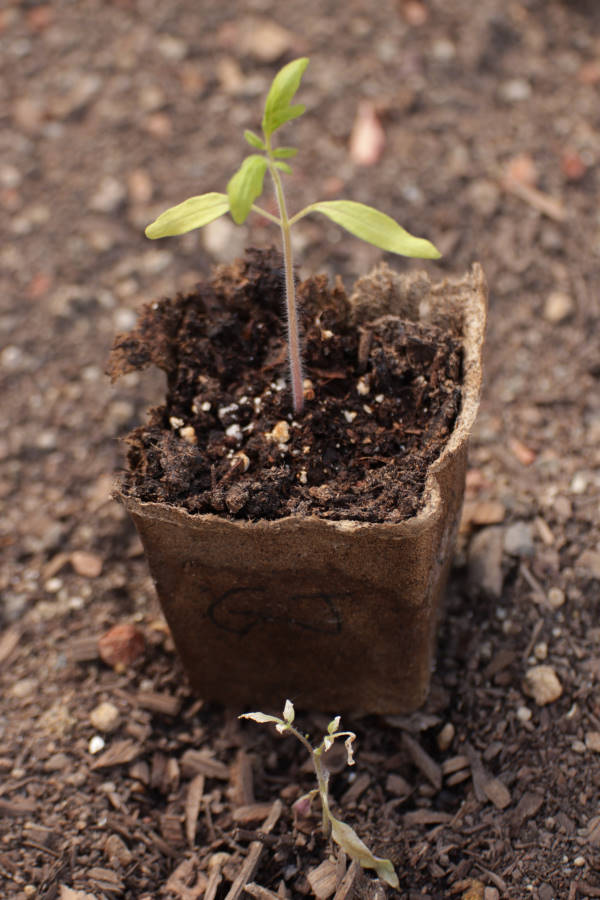TOMATO CROP UPDATE 10th of May 2023, Sebastopol, California

The photo above shows a San Marzano paste tomato seedling in its pot – kept indoors – compared to the same variety transplated at the end of April – near the base of the pot.
Two weeks ago, at the end of April, we started to transplant our tomato seedlings into our new raised beds.
( I’ll describe the construction of our gopher proof, plywood raised beds in a separate blog post coming soon.)
What I want to report today is the condition of the tomato seedlings in our raised beds after 2 weeks of exposure to outdoor conditions.
Green Valley Climate
The surprising thing about the climate here just West of Sebastopol, California, is that every night the temperature tends to dip down by 20 or 30 degrees Fahrenheit.
While in May we can see balmy temperatures from the mid 70s to the low 80s during the day, the temperature will normally dip down into the mid 40s in the early hours of the morning.
This happens when cold air over the North Pacific Ocean flows inland through the Petaluma Gap during the night.
Over the last two weeks the outside air temperature dipped well below the safe temperature of 65° F for tomato plants.
In fact, during the first week after we had transplanted our tomato seedlings, the average low temperature dipped down to 47 F.
The temperature dropped even lower on the 5th when it went down to 44 F, and then down to 41 F on the 7th, while early this morning it dipped down to 43 F.
The Effect of Night Time Chills
As a result, two of our tomato varieties were killed off, outright, by the night time chill. The two tomato varieties that perished were the San Marzano paste tomatoes (top photo), and the German Johnson heirloom tomatoes (photo below.) All nine of the transplanted German Johnson seedlings are deceased as well as all 18 apart from one or two.
The photo below shows a German Johnson beafsteak tomato seedling in its pot – kept indoors – compared to the same variety transplated at the end of April – near the base of the pot.

Luckily, we kept half of the German Johnsons indoors, so those seedlings are doing quite well.
Unfortunately, we’ll have to start from scratch with the San Marzanos.
Meanwhile, three varieties survived. Two seem to be doing well although they are not growing. The two doing well despite the low temperatures are the Edox hybrid (a ½ ounce grape or cherry tomato, below, at left) and the Brandy Wine heirloom (below, at right – a large beefsteak tomato variety similar to the German Johnson). The Edox and Brandy Wines have shown a night and day difference compared to the San Marzanos and the German Johnsons.


A fifth tomato variety, the Big Beef heirloom, is doing okay, but it’s not thriving (photo below.) Some of the Big Beef variety seedlings are showing limited damage along the fringes of the second set of leaves, but looks like they will recover.

Conclusion
Clearly, the outside nightly low temperature is way too cold for 2 out of 5 tomato varieties here in the Green Valley of Northern California, where the cold air over the North Pacific ocean moves inland during the night.
Digging in to find a solution
I want to do something to ensure we harvest the most productive tomato crop for all five varieties.
I’ve looked up the historical average temperature averages. Even in July the nightly low is 50 F on average. Soil temperatures are more encouraging. Temperature measurements at 2:30pm, 4 inches deep, in the center of the raised beds are 69 +/- 2° F. This is plenty warm for tomato growth. I’m going to repeat the measurements early in the morning before the soil has had a chance to warm up in the sun. I suspect that the large thermal mass of the damp soil will retain heat and not fluctuate too much over a 24-hour period.
I must contend with an unavoidable overnight dip in air temperature that is characteristic of the Green Valley here in Northern California, by virtue of the cold Alaska Current that flows down along our coast.
The best idea I have so far is to set up a polytunnel over each row of tomato seedlings to trap in warm air overnight.
In a future post, I’ll report on the benefits of the polytunnels.
Cheers and until next time happy gardening!
